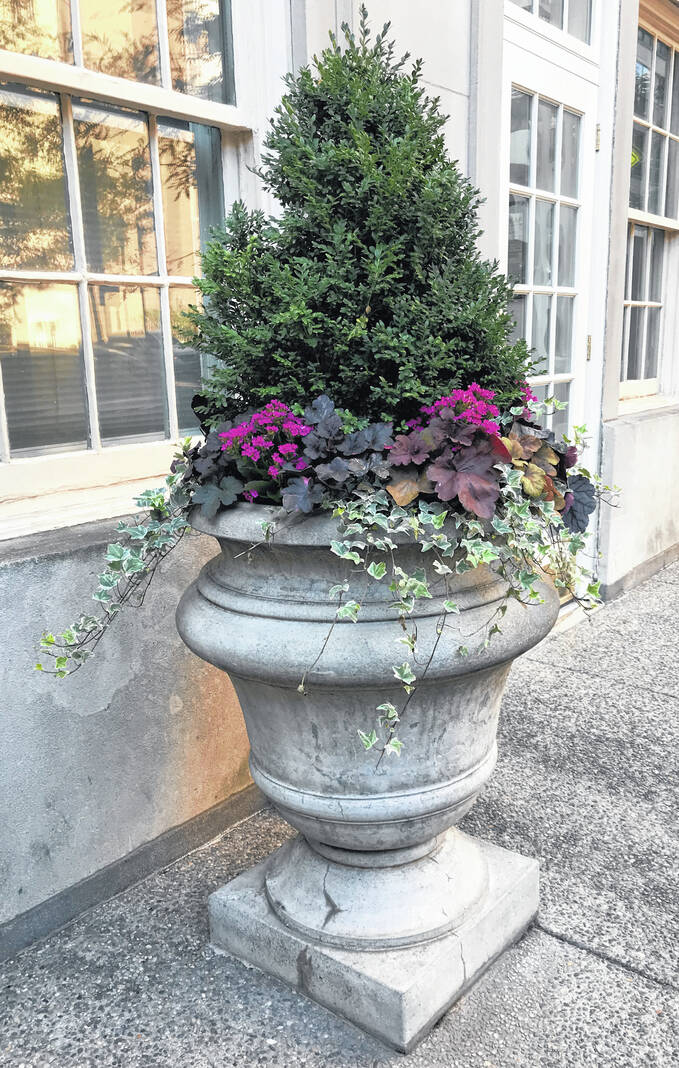
Steve Boehme

You shouldn’t be stingy about filling large pots with good potting soil, and replacing it each year.
The key to success in container gardening is having the right “soil”, or potting mix. The potting “soil” used to grow container plants is really not soil at all. True soils are field soils that often retain too much water, have too little pore space (for oxygen), are too heavy, and potentially harbor harmful diseases, insects, and weeds. Because of these drawbacks, commercial growers never use field soils (topsoil) for growing plants in containers.
Potting soil is a mixture of peat moss and other organic materials like fine-ground pine bark. True potting soil is actually “soil-less”. Potting soil is mostly air so it’s light, lets water drain easily, and dries out quickly. Potting soil is fluffy and won’t pack down. Potting soils allow excess water to quickly drain out the bottom of the container by gravity, pulling in air to replace the water. Since plants breathe through their roots, they’ll thrive in potting soil as long as they are watered regularly.
Potting soils are precisely mixed using strict formulas and recipes. Most potting soils are based on peat moss, with other ingredients added to make them ideal for certain plants. For example, seed starter mixes are very fine and fluffy, with a little bit of fertilizer, so that fragile, fine roots grow rapidly. Perennial mixes have larger pieces and more bark. Some potting soils include vermiculite or perlite; flakes of fluffy featherweight rock that’s been puffed up so it holds lots of air. Good potting soils are sterile, meaning they have absolutely no weed seeds or diseases in them.
Commercial growers are in the business of turning seedlings into saleable plants as quickly as possible, so they really focus on having exactly the right recipe container mix for each particular crop. They are well aware that plants need oxygen in their root zone; as any “green thumb” gardener knows, this is the key to healthy plants.
There are many commercial soilless mixes developed through scientific research that provide optimum water and nutrient properties. Most commercial mixes combine finely textured and coarsely textured components to create a balance of water retention and drainage qualities. You may need to experiment with several mixes to find which ones work best for which plants.
Many high-quality commercial potting mixes have a small quantity of fertilizer mixed in to give newly potted plants a surge of nutrients to jump-start their growth. In most cases, these nutrients last only a couple of weeks and often do not supply the full spectrum of nutritional elements needed for long-term growth, so we like to mix low-nitrogen, slow-release fertilizers with our potting soils when planting, and then replenish the mix with liquid fertilizer during the season.
You shouldn’t be stingy about filling large pots with good soil, and replacing it each year. Large soil volume encourages healthy roots. Exhausted or compacted soil does not. Last year’s container soil can harbor diseases or insect eggs. If you really want to succeed with containers, you need to invest in enough quality potting mix each year, and not skimp.
Steve Boehme is a landscape designer/installer specializing in landscape “makeovers”. “Let’s Grow” is published weekly; column archives are online at www.goodseedfarm.com. For more information call GoodSeed Farm Landscapes at (937) 587-7021.

